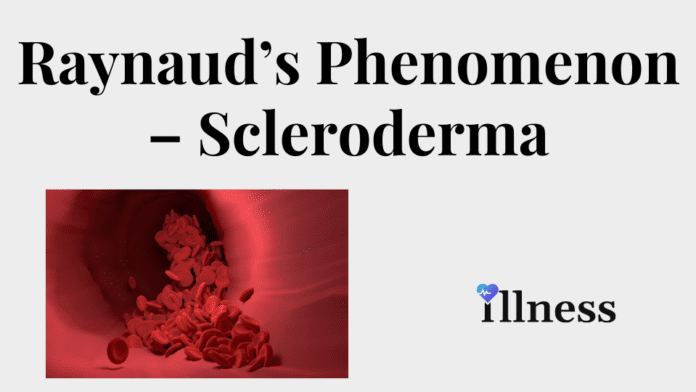Overview Of Scleroderma
Scleroderma is a disease that involves the buildup of scar-like tissue in the skin and elsewhere in the body. It also damages the cells that line the walls of small arteries.
Commonly Associated With
Progressive systemic sclerosis; Systemic sclerosis; Limited scleroderma; CREST syndrome; Localized scleroderma; Morphea – linear; Raynaud’s phenomenon – scleroderma
Causes Of Scleroderma
Scleroderma is a type of autoimmune disorder. In this condition, the immune system mistakenly attacks and damages healthy body tissue.
The cause of scleroderma is unknown. A buildup of a substance called collagen in the skin and other organs leads to the symptoms of the disease.
The disease most often affects people ages 30 to 50 years. Women get scleroderma more often than men. Some people with scleroderma have a history of being around silica dust and polyvinyl chloride, but most do not.
Widespread scleroderma can occur with other autoimmune diseases, including systemic lupus erythematosus and polymyositis. These cases are referred to as undifferentiated connective tissue disease or overlap syndrome.
Symptoms Of Scleroderma
Some types of scleroderma affect only the skin, while others affect the whole body.
- Localized scleroderma, (also called morphea) — Often affects only the skin on the chest, abdomen, or limb but not usually on the hands and face. Morphea develops slowly, and rarely spreads in the body or causes serious problems such as internal organ damage.
- Systemic scleroderma, or sclerosis — May affect large areas of skin and organs such as the heart, lungs, or kidneys. There are two main types, limited disease (CREST syndrome) and diffuse disease.
Skin signs of scleroderma may include:
- Fingers or toes that turn blue or white in response to cold temperatures (Raynaud phenomenon)
- Stiffness and tightness of skin of fingers, hands, forearm, and face
- Hair loss
- Skin that is darker or lighter than normal
- Small white lumps of calcium beneath the skin that sometimes ooze a white substance that looks like toothpaste
- Sores (ulcers) on the fingertips or toes
- Tight and mask-like skin on the face
- Telangiectasias, which are small, widened blood vessels visible beneath the surface on the face or at the edge of fingernails
Bone and muscle symptoms may include:
- Joint pain, stiffness, and swelling resulting in loss of motion. The hands are often involved due to fibrosis around tissue and tendons.
- Numbness and pain in the feet.
Breathing problems may result from scarring in the lungs and can include:
- Dry cough
- Shortness of breath
- Wheezing
- Increased risk for lung cancer
Digestive tract problems may include:
- Difficulty swallowing
- Esophageal reflux or heartburn
- Bloating after meals
- Constipation
- Diarrhea
- Problems controlling stools
Heart problems may include:
- Abnormal heart rhythm
- Fluid around the heart
- Fibrosis in heart muscle, decreasing heart function
Kidney and genitourinary problems may include:
- Development of kidney failure
- Erectile dysfunction in men
- Vaginal dryness in women
Exams & Tests
The health care provider will do a complete physical exam. The exam may show:
- Tight, thick skin on the fingers, the face, or elsewhere.
- The skin at the edge of the fingernails may be looked at with a lighted magnifying glass for abnormalities of the small blood vessels.
- The lungs, heart and abdomen will be examined for abnormalities.
Your blood pressure will be checked. Scleroderma can cause small blood vessels in the kidneys to become narrowed. Problems with your kidneys can lead to high blood pressure and decrease the function of the kidney.
Blood and urine tests may include:
- Antinuclear antibody (ANA) panel
- Scleroderma antibody testing
- ESR (sed rate)
- Rheumatoid factor
- Complete blood count
- The metabolic panel, including creatinine
- Heart muscle tests
- Urinalysis
Other tests may include:
- Chest x-ray
- CT scan of the lungs
- Electrocardiogram (ECG)
- Echocardiogram
- Tests to see how well your lungs and gastrointestinal (GI) tract are working
- Skin biopsy
Treatment Of Scleroderma
There is no specific treatment for scleroderma. Your provider will assess the extent of disease in the skin, lungs, kidneys, heart, and gastrointestinal tract.
People with diffuse skin disease (rather than limited skin involvement) may be more prone to progressive and internal organ disease. This form of the disease is classified as diffuse cutaneous systemic sclerosis (dcSSc). Body-wide (systemic) treatments are most often used for this group of patients.
You will be prescribed medicines and other treatments to control your symptoms and prevent complications.
Medicines used to treat progressive scleroderma include:
- Corticosteroids such as prednisone. However, doses above 10 mg per day are not recommended because higher doses may trigger kidney disease and high blood pressure.
- Drugs that suppress the immune system such as mycophenolate, cyclophosphamide, cyclosporine, or methotrexate.
- Hydroxychloroquine to treat arthritis.
Some people with rapidly progressive scleroderma may be candidates for autologous hematopoietic stem cell transplantation (HSCT). This type of treatment needs to be performed in specialized centers.
Other treatments for specific symptoms may include:
- Treatments to improve Raynaud phenomenon.
- Medicines for heartburn or swallowing problems, such as omeprazole.
- Blood pressure medicines, such as ACE inhibitors, for high blood pressure or kidney problems.
- Light therapy to relieve skin thickening.
- Medicines to improve lung function, such as bosentan and sildenafil.
Treatment often involves physical therapy as well.
Other
In some people, symptoms develop quickly for the first few years and continue to get worse. However, in most people, the disease gets worse slowly.
People who have only skin symptoms have a better outlook.
Widespread (systemic) scleroderma can lead to.
- Heart failure
- Scarring of the lungs called pulmonary fibrosis
- High blood pressure in the lungs (pulmonary hypertension)
- Kidney failure (scleroderma renal crisis)
- Problems absorbing nutrients from food
- Cancer



